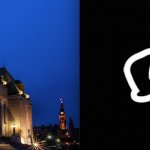Free expression … within limits
Commentary
Controversy over Prophet Muhammad cartoons fuels debate over the limits of freedom of expression. Dean Jobb comments.
By Dean Jobb
As the debate raged over publication of the Prophet Muhammad cartoons in February 2006, about 100 students gathered at the fortress-like administration building at Saint Mary’s University in Halifax on a mild winter afternoon to denounce one of their professors.
“Peter March is a fool,” they chanted, “we don’t want you in our school.” March, who teaches philosophy, posted the cartoons on his office door not long after their republication in European newspapers sparked outrage and violence in the Muslim world.
When university officials ordered March to remove the images, he went public and cast himself as a defender of academic freedom and freedom of expression. March describes himself as a “public philosopher” and does not shy away from publicity or controversy. He even caused a stir by boldly wading into the crowd protesting his actions.
As the protest’s leader used a megaphone to freely denounce March, academic freedom and free speech were being exercised in the seminar room of an adjacent building.
A consultant on cultural policy noted how tough it is for Canadian filmmakers to get their movies into commercial theatres. Empire Theatres has a lock on cinemas in Atlantic Canada, he noted, and prefers to screen lucrative Hollywood blockbusters.
The powerful Sobey’s supermarket family owns Empire Theatres, and this criticism of its failure to promote cultural nationalism was made in the Sobey Building, home of the Sobey School of Business.
The freedom to criticize a company within the very walls the company built – this is the essence of freedom of expression, whether in an academic setting, at a public protest or in a news story.
Freedom of expression is the right – a fundamental right of all Canadians, protected under the Charter of Rights and Freedoms – to speak openly and freely. But it is not a licence to do harm.
That’s why there are legal limits on freedom of expression. Publication bans and the law of contempt restrict what journalists can report about a crime while a case is before the courts. Why? To ensure the person accused of the crime – someone our justice system presumes to be innocent until proven guilty – is tried in the courtroom, not in the media.
A media outlet that publishes or broadcasts unfounded allegations that sully the reputation of a person or a company can be sued for libel. Inciting hatred against an identifiable group is a hate crime. It is illegal to publish or distribute child pornography.
We should debate where the lines should be drawn, and this debate has been under way in Canada’s courts since the Charter came into force more than two decades ago. But no one would seriously argue there should be no limits on freedom of expression.
Imagine the impact on the media’s credibility, for instance, if there were no libel laws. Who could believe anything printed in the newspaper if the newspaper was free to print anything it wanted, regardless of whether the statement or allegation were true?
The law deals with abuses of the right to freedom of expression. But common sense and restraint also come into play. The Canadian media, with few exceptions, showed restraint and did not republish the images.
As the Globe and Mail’s editor-in-chief, Edward Greenspon, argued in his weekly column at the height of the controversy, republishing the cartoons while people were dying in violent protests against their dissemination “would be both gratuitous and unnecessarily provocative.”
This decision was “not a matter of self-censorship,” he added. “It is a question of editing.” Editors make judgment calls every day. Should a politician who uses profanity be quoted verbatim? Is the photo of the accident victim too graphic? Is there enough evidence to support the allegation of corruption being leveled at a politician?
Journalists self-edit with an eye to ethical considerations and good taste. The test is the newsworthiness of the material and whether it is essential to telling the story.
Not exercising the right to free expression, as Greenspon noted, does not mean that right has been surrendered for all time “We will take the risk of giving offence when we deem it appropriate,” he assured Globe readers. The Globe, like almost all other Canadian news organizations, described the cartoons in detail and covered the ensuing debate and protests. It was not necessary to republish the cartoons – which anyone can call up on Google in a matter of seconds, in any event – in order to tell the story.
The only publication of any stature to publish the cartoons was the Calgary-based Western Standard magazine. Its editor, Ezra Levant, said he ran the “relatively innocuous” cartoons – innocuous to him, at least – because “you can’t properly report that story without showing the cartoons.”
In other words, it was a judgment call, and a poor one at that.
The Canadian Association of Journalists issued a press release supporting the right of the Western Standard and other Canadian media outlets to republish the cartoons. “Re-publication of the cartoons, when done after thoughtful consideration as to their purpose, can offer context to the news coverage of the impact of their original appearance.”
There were few takers, if any. As CAJ president Paul Schneiderheit acknowledged in the release, the right to publish is “tempered by law and common sense.”
As it should be. Reporters and editors must apply news judgment and common sense to every story they do – otherwise, we’re little more than conduits for government spin-doctors, corporate flacks, hate-mongers and every conspiracy theorist who picks up the phone and calls the newsroom. With freedom comes responsibility. The right to free expression should never be mistaken for a licence to publish.
——————————————–
Dean Jobb, an assistant professor of journalism at the University of King’s College, is author of Media Law for Canadian Journalists, published by Emond Montgomery Publications (www.emp.ca/books/093-4.html).
This article originally appeared in the Spring 2006 edition of Media, the magazine of the Canadian Association of Journalists




